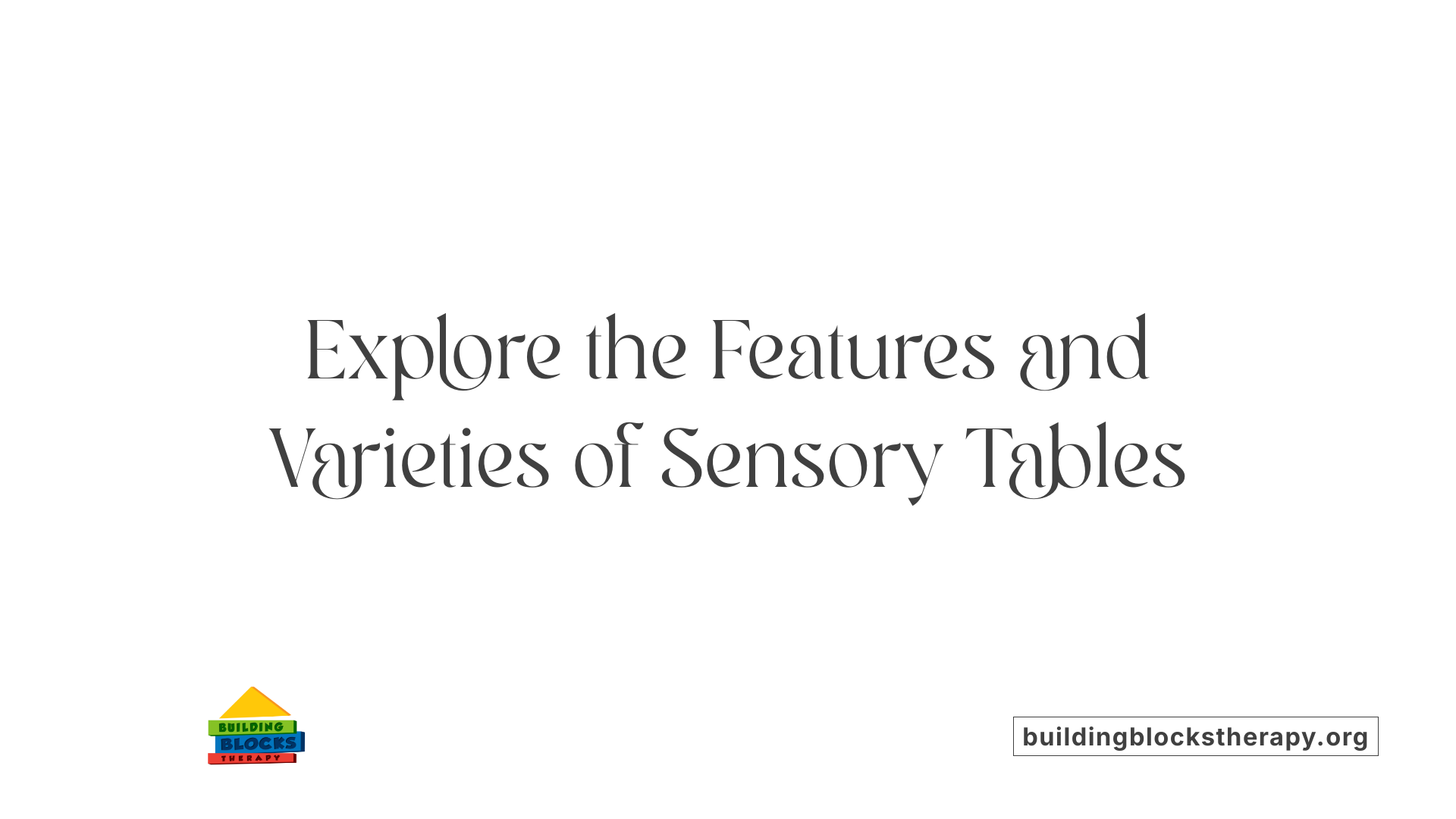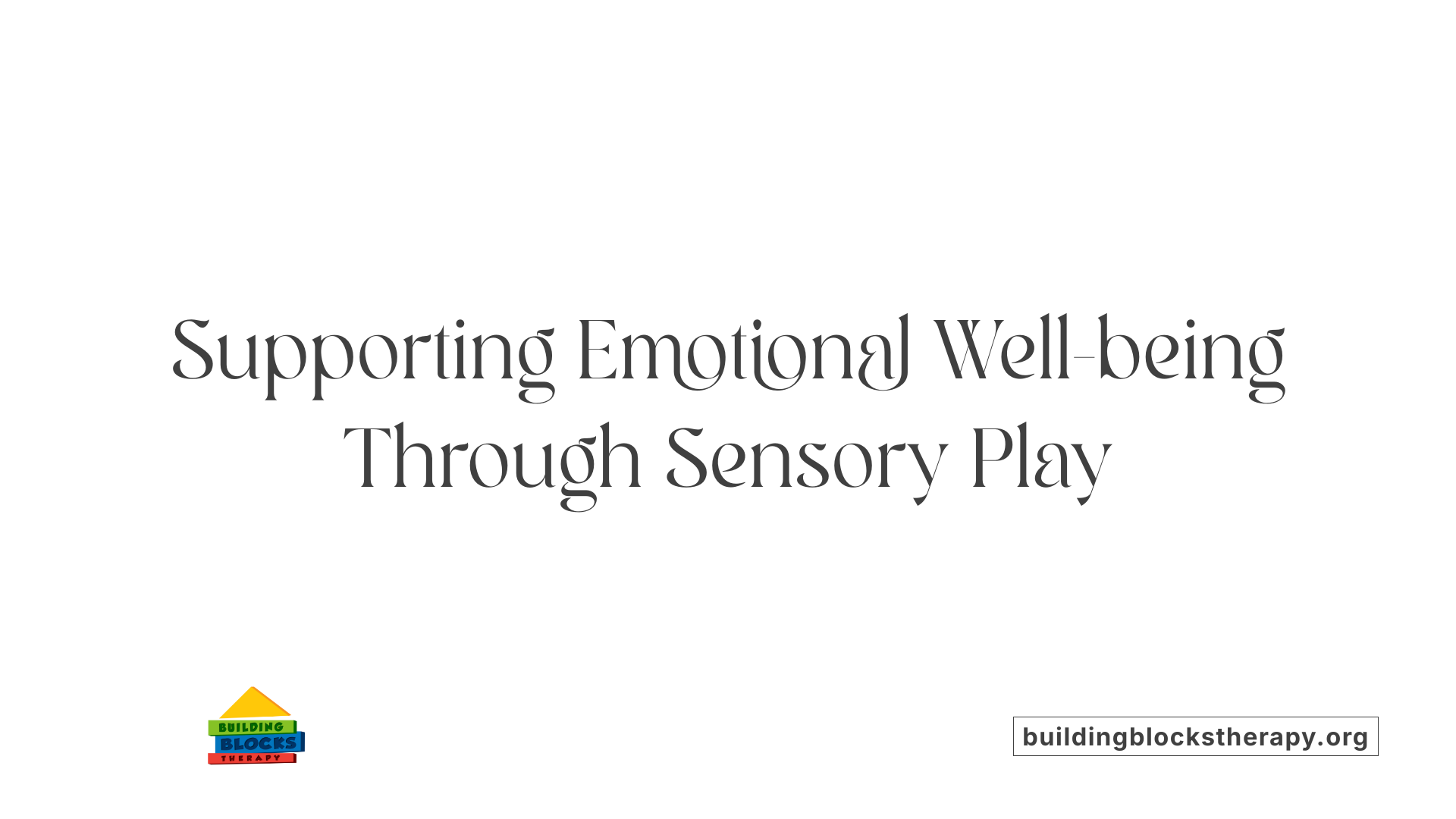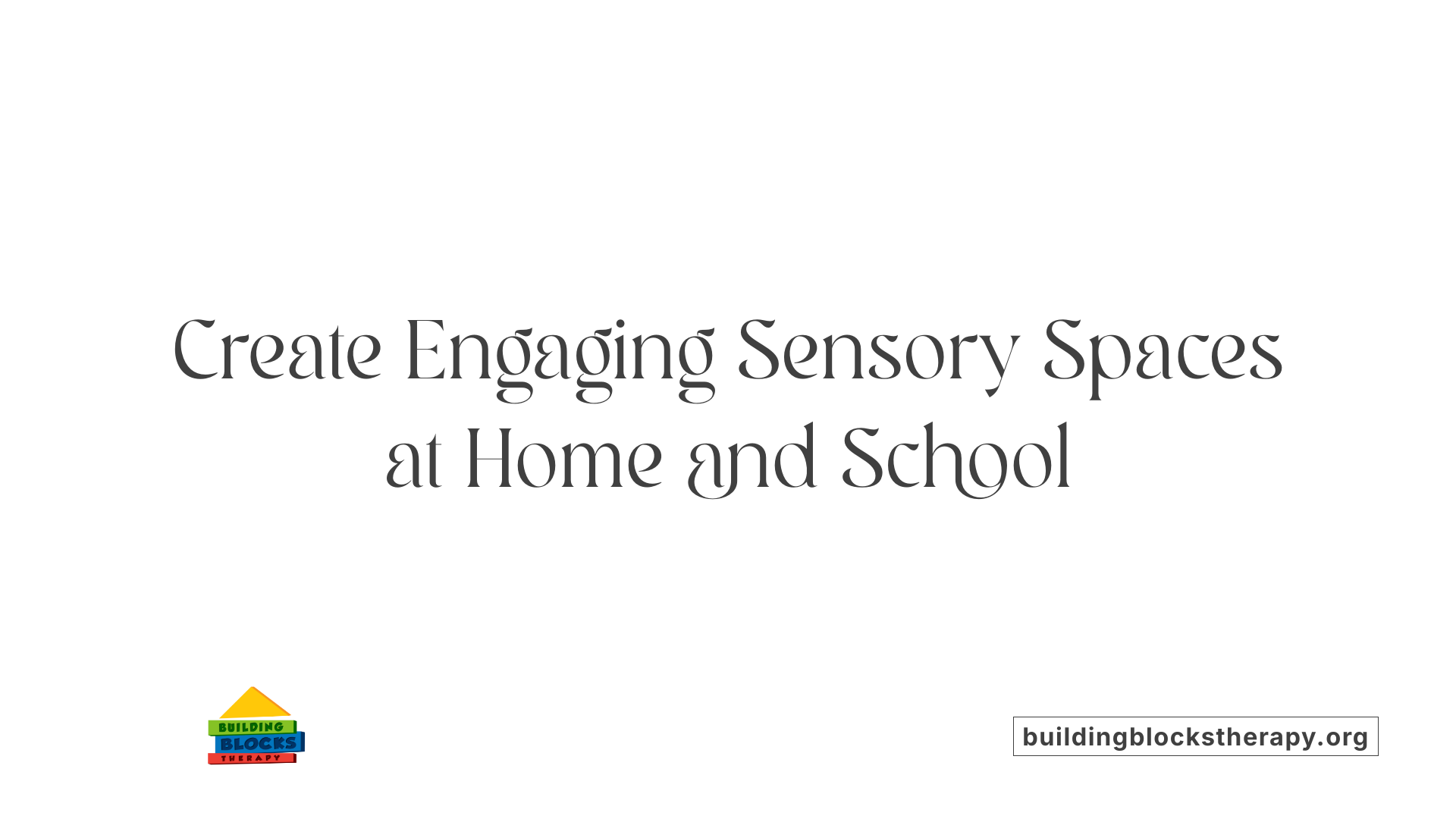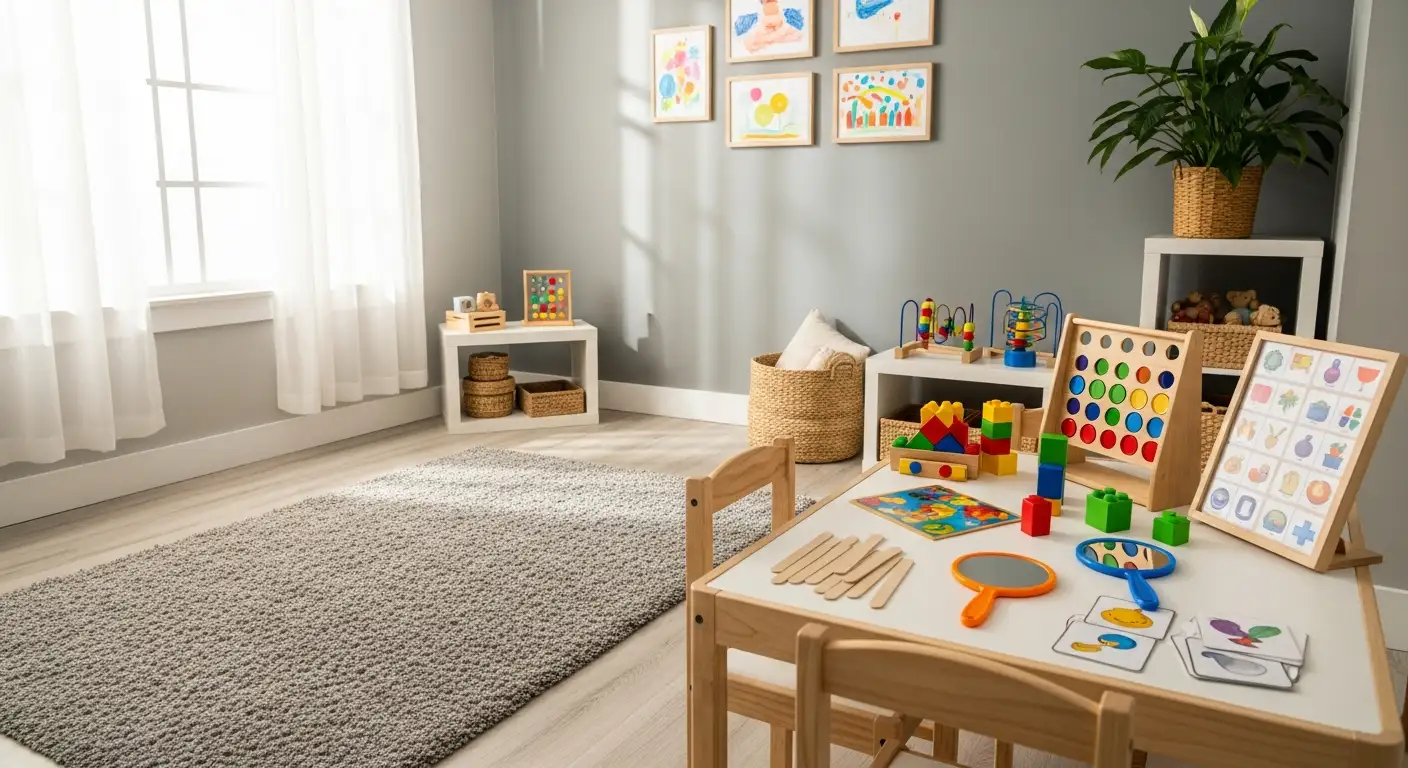Understanding the Role of Sensory Tables in Autism Support
Sensory tables are innovative tools that can significantly improve the developmental and emotional well-being of children with autism. By providing engaging multi-sensory experiences, these tables support sensory processing, facilitate learning, and promote social interaction. This article explores the purpose, benefits, features, and versatile uses of sensory tables tailored for children on the autism spectrum.
The Purpose and Benefits of Sensory Tables for Children with Autism

What is the purpose of sensory tables in supporting children with autism?
Sensory tables are designed to offer structured sensory experiences that support children with autism. These tables provide opportunities for children to explore different textures, liquids, and materials, which can improve their sensory processing and promote neural development. The activities involved—such as pouring water, scooping sand, or feeling different textures—encourage participation and help children develop better coordination and fine motor skills.
Sensory tables also foster social interaction and communication. Children can play side-by-side, share tools, or describe what they feel and do, building social skills like turn-taking and sharing. Additionally, the calming effects of activities like water or rice play help reduce anxiety and emotional stress, creating a soothing environment for children to learn and relax.
Overall, sensory tables are valuable tools in promoting emotional regulation, social growth, and developmental progress in children with autism.
Features and Types of Sensory Tables for Autistic Children

What are the features and types of sensory tables suitable for children with autism?
Sensory tables designed for children with autism often include features that support a safe, customizable, and engaging sensory experience. These tables typically have adjustable height options to accommodate children of different ages and physical abilities, making them accessible and comfortable for various users. Durability and waterproof materials are essential, allowing children to explore different textures without concerns about damage or mess.
Many sensory tables feature compartments or sections where different materials can be organized separately. This design helps children distinguish between textures and enhances sensory exploration. Filling these tables with diverse tactile stimuli—such as sand, water, rice, beans, pasta, or themed items—encourages curiosity, fine motor skills, and imaginative play.
Different types of sensory tables serve particular sensory experiences and developmental goals. Common varieties include water tables, sand tables, and sensory bins, which can be customized with additional features to maximize their benefits.
Additional enhancements like sun umbrellas protect children from direct sunlight during outdoor play, while lids keep materials clean and prevent spills. Tools like scoops, tweezers, cups, and brushes enrich play by encouraging fine motor development and cooperative interaction.
Whether used at home, in therapy clinics, or classrooms, these tables promote calming, sensory integration, communication skills, and motor development. Their adaptable design makes them practical and effective tools tailored to the unique needs of children with autism.
How do sensory tables support sensory processing needs in children with autism?
Sensory tables play a vital role in helping children with autism process sensory information in a safe, structured way. They provide a controlled environment where children can explore different textures and mediums, aiding in sensory regulation and integration.
By engaging with textures such as sand, water, moon dough, magnetic materials, and themed items, children can experience a variety of sensory inputs that can be tailored to individual preferences and sensitivities. This customization supports sensory discrimination and helps children better understand their sensory world.
Activities involving sensory tables often promote language development and social interaction. For example, children may work together to pour, scoop, or build, fostering communication and cooperation. The cause-and-effect nature of play with sensory materials encourages cognitive growth and problem-solving skills.
Furthermore, sensory table activities can have a calming effect, reducing over-stimulation and helping children self-regulate emotions. The safe, predictable environment of a sensory table allows children to explore without feeling overwhelmed.
Overall, sensory tables are versatile tools that facilitate sensory processing, emotional stability, and developmental progress, making them invaluable assets for supporting children with autism in various settings.
| Feature/Type | Description | Benefits |
|---|---|---|
| Adjustable Height | Enables customization for different ages and physical abilities | Improved comfort and accessibility |
| Waterproof Materials | Ensures durability and safety for water and messy play | Safe exploration and easy cleaning |
| Compartments | Organizes various sensory materials for better engagement | Enhanced sensory discrimination |
| Tactile Stimuli Varieties | Sand, water, rice, themed items, moon dough, and magnetic materials | Rich sensory experiences |
| Types of Tables | Water tables, sand tables, sensory bins, landscape tables | Different sensory and educational benefits |
| Additional Features | Sun umbrellas, lids, tools (scoops, tweezers, cups) | Protection, cleanliness, skill development |
This array of features and types illustrates the adaptability and usefulness of sensory tables tailored for children with autism. Properly equipped and chosen based on individual needs, these tables can significantly enhance sensory processing, emotional regulation, and overall development.
Supporting Sensory Regulation and Emotional Well-being

How do sensory tables support sensory processing needs in children with autism?
Sensory tables are invaluable tools that help children with autism manage their sensory processing challenges. By providing a controlled environment filled with different textures and materials—such as water, sand, moon dough, or magnetic substances—they allow children to explore sensory stimuli at their own pace. This exploration supports sensory regulation by helping children organize and interpret sensory input more effectively.
Such tables can be tailored to suit individual preferences, making sensory activities both safe and enjoyable. Through play, children develop better sensory integration, which contributes to calmer behavior and less overstimulation. They also promote language development and social interaction, as children often engage with peers during shared activities involving the sensory table.
Moreover, manipulating various textures enhances fine motor skills. For example, scooping water or shaping moon dough strengthens hand muscles and improves coordination. Importantly, sensory tables often have a calming effect, reducing feelings of anxiety and frustration among children with autism who may struggle with sensory overload.
Overall, sensory tables serve as versatile tools that foster emotional regulation and sensory processing, helping children feel more secure and confident in their abilities to handle sensory input.
How can sensory tables be used for educational and therapeutic purposes in autism intervention?
Sensory tables are practical assets in both educational and therapeutic settings for children with autism. They can be customized to align with developmental goals and individual interests, making learning engaging and effective.
Educationally, sensory tables promote exploration of scientific concepts like cause-and-effect, buoyancy, and texture differences. For example, children might discover how water reacts when objects are submerged or how sand can be shaped and molded. These activities actively support cognitive development, scientific curiosity, and problem-solving skills.
Therapeutically, sensory tables help children regulate emotions and improve focus. By providing tactile stimulation through materials like moon dough or mud, they can reduce anxiety and frustration. This calm state makes it easier for children to participate in other learning or therapy activities.
Social interaction is encouraged through shared activities, such as building castles with LEGO bricks or creating landscapes in sensory bins. These group experiences foster communication, cooperation, and social skills essential for well-rounded development.
Sensory tables are often inexpensive and easy to assemble at home, making them accessible tools for ongoing intervention. They support fine motor development, enhance sensory processing, and promote emotional well-being—integral components of comprehensive autism support.
What are some examples of sensory tables?
Various sensory tables exist, catering to different interests and developmental needs. Popular examples include:
- Water tables: Encourage pouring, splashing, and water manipulation.
- Sand tables: Offer tactile exploration and construction activities.
- Moon dough tables: Provide a soft, moldable material for creative play.
- Mud and bugs tables: Simulate nature, promoting outdoor interests.
- Spell my name tables: Build literacy and fine motor skills.
- Counting tables: Support numeracy and cognitive growth.
- LEGO building tables: Enhance fine motor skills, creativity, and social interaction.
- Landscape tables: Foster imaginative play and scientific understanding.
- Book tables: Combine sensory exploration with literacy activities.
Using these diverse options, caregivers and educators can tailor sensory experiences to meet individual needs while encouraging a wide range of developmental skills.
How do sensory tables promote social skills, scientific discovery, love of nature, and literacy?
Sensory tables serve as gateways to learning and socialization. When children engage with others around sensory activities, they naturally develop communication and cooperation skills.
For instance, collaborative projects like building landscapes or sharing water play foster teamwork and turn-taking. These interactions improve social understanding and emotional development.
Scientific discovery is stimulated through hands-on experiments—such as observing water flow or moldability of dough—that ignite curiosity.
Additionally, sensory tables that mimic natural environments—like mud and bug tables—instill an appreciation for nature. This early exposure can foster environmental awareness and love for the outdoors.
Literacy skills are also supported when sensory play integrates reading and storytelling. For example, labeling materials or creating stories around sensory creations enhance vocabulary and narrative abilities.
Overall, sensory tables bridge multiple domains of development, making learning engaging, fun, and meaningful.
Are sensory tables accessible and easy to set up at home?
One of the advantages of sensory tables is their accessibility. They can be assembled at home using inexpensive or readily available materials.
Simple setups include large plastic bins filled with water, sand, or rice. DIY options like moon dough or mud can be made with common household ingredients. Many tutorials and guides are available online to assist in creating safe, engaging sensory play spaces.
In addition to being cost-effective, they are adjustable in size and complexity to suit different age groups and developmental stages.
Having a sensory table at home promotes regular sensory exploration, which is vital for children with autism. It also provides a calming activity that can be used to facilitate transitions between tasks or to manage sensory sensitivities.
In summary, sensory tables are versatile, affordable, and easy to incorporate into the daily routine, supporting ongoing sensory and emotional development.
Incorporating Sensory Tables in Home and Classroom Settings

How can sensory tables be used for educational and therapeutic purposes in autism intervention?
Sensory tables serve as versatile tools that can be tailored to meet individual needs, making them highly effective in supporting children with autism. These tables offer structured opportunities for sensory input, which can enhance attention and engagement. Tactile activities with water, sand, or DIY options like moon dough and mud and bugs tables help develop fine motor skills, hand-eye coordination, and muscle control.
In addition to physical development, sensory tables promote social interaction and communication. Children often engage in parallel or shared play, especially when activities involve LEGO building, landscape creation, or collaborative sensory bin exploration. These interactions support social skills like turn-taking and communication, providing a natural setting for peer engagement.
Moreover, sensory tables have a calming effect, helping children regulate emotions and transition smoothly between different activities or routines. Their adaptability and capacity for customization make them excellent resources for promoting growth, exploration, and emotional well-being in children with autism.
How readily can sensory tables be assembled at home using inexpensive or readily available materials?
Creating a sensory table at home is accessible and cost-effective, making it a practical option for many families. The process often involves repurposing household items such as plastic storage bins, shallow containers, or even large trays. These can be filled with various materials like water, rice, beans, sand, or themed items to match a child’s interests.
Designing a sensory table can be as simple as an outdoor or indoor setup, depending on space and preference. For example, a plastic tub filled with water and some floating toys can serve as a water table, while a large tray filled with sand or rice provides tactile exploration.
Additional accessories, including scoops, spoons, small tools, and themed items like herbs or rocks, can enhance the sensory experience and support developmental goals such as fine motor coordination. Many families integrate sensory tables into daily routines, fostering ongoing sensory play that promotes learning, emotional regulation, and curiosity.
Versatility and adaptability of sensory tables
Sensory tables are highly adaptable to individual needs, developmental stages, and interests. They can be modified by changing materials, adding visual or auditory stimuli, or incorporating educational elements like numbers, shapes, or letters. For example, a spelling table with letter tiles or a counting table with number beads can support early literacy and numeracy skills.
Furthermore, sensory tables can be used across various settings including therapy rooms, classrooms, or homes. They serve as valuable tools in therapy programs, early childhood classrooms, and at-home routines, offering consistent opportunities for sensory exploration and skill development.
| Setting | Types of Activities | Materials Used | Benefits |
|---|---|---|---|
| Home | DIY sensory bin play, herbal tables | Sand, herbs, water, rice, toys | Cost-effective, easily customizable |
| Classroom | Group sensory activities, educational games | LEGO, landscape models, book tables | Promote social skills and literacy |
| Therapy | Sensory regulation, motor skill development | Moon dough, mud tables, counting tables | Support emotional regulation and fine motor skills |
Sensory tables' adaptability ensures they can be tailored to suit personal needs and interests, making them a valuable addition to any environment supporting children with autism.
Fostering Growth and Well-Being Through Sensory Play
Integrating sensory tables into the routine of children with autism offers a wealth of developmental benefits. From supporting sensory processing and motor skills to providing a calming environment and fostering social interactions, these versatile tools are invaluable in both educational and therapeutic settings. Whether used at home, in clinics, or classrooms, sensory tables can be tailored to meet individual needs, making sensory play an accessible and effective approach to promoting well-being and growth in children with autism.
References
- 10 Sensory Table Ideas For Autistic Children
- 10 Sensory Table Ideas For Autistic Children
- How A Sensory Table Can Benefit Your Child
- 10 Sensory Table Ideas For Autistic Children
- The Benefits of Sensory Bins for Children With Autism
- The Benefits of Sensory Bins for Children With Autism
- Sensory Bins for Children: What Are the Benefits? - WebMD






